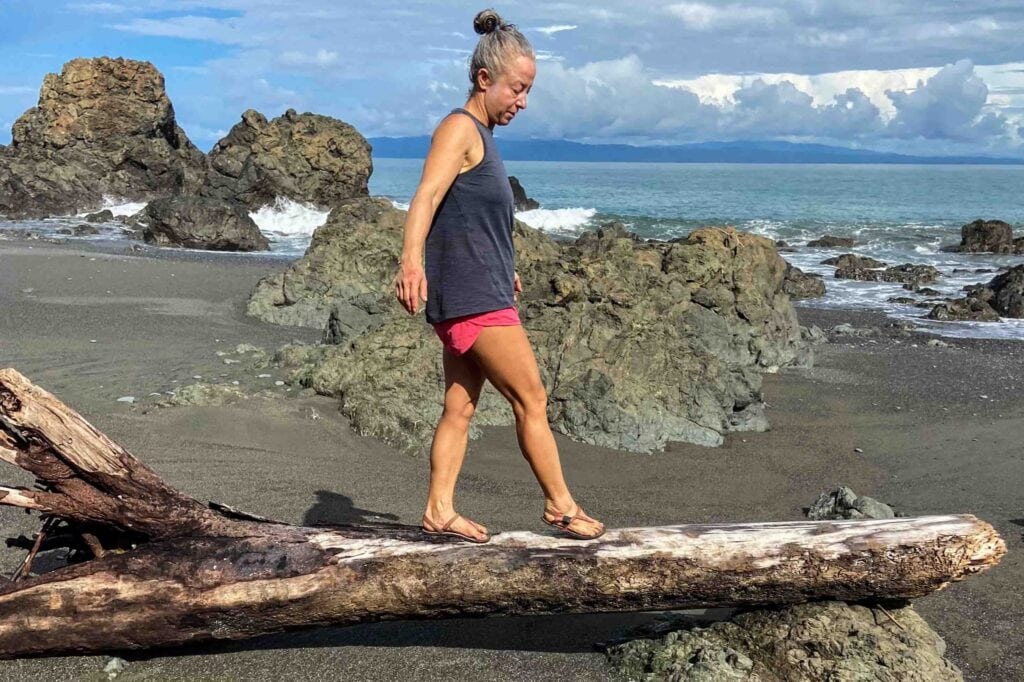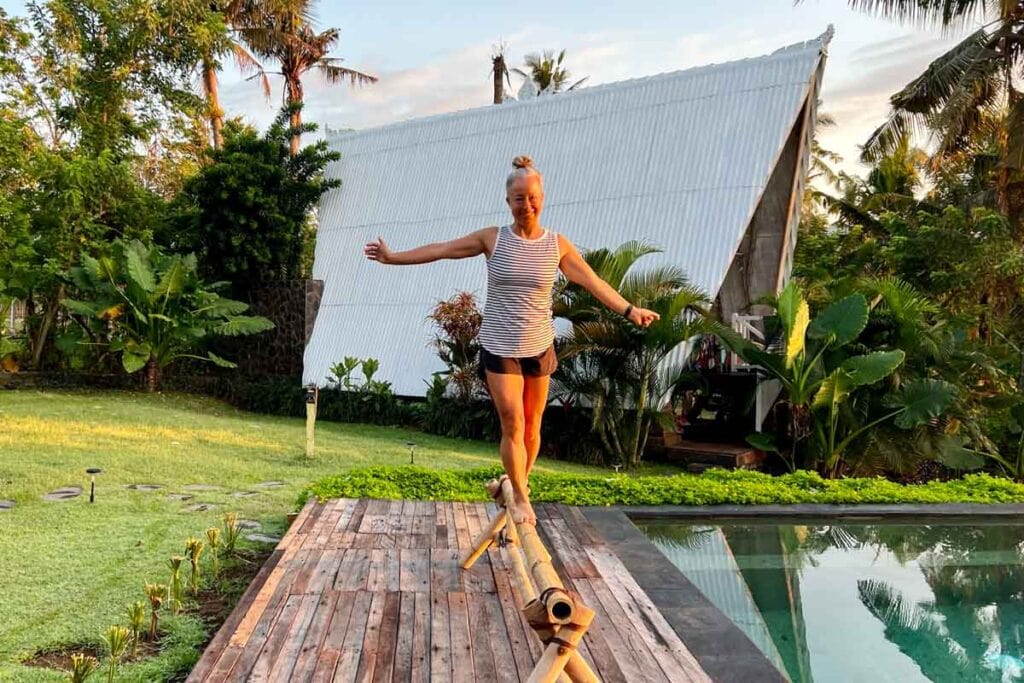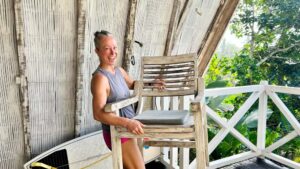We spend a surprising amount of time balancing on one leg. Seriously – if your fitness tracker was smart enough, it would tell you that about 80% of the time you spend walking is actually on one foot at a time. Although we can mask poor balance with momentum, it can lead to a major risk of falls if we come across uneven ground or obstacles or even turn our head. If we want to stay active and avoid injuries, we need to talk about balance training!
Balance is especially important as we age, when the consequences of falling are much higher. Even if an older person is in pretty good health, a bad fall can result in broken bones and incapacitation, leading to muscle loss, disease progression and even death. In America, falls among older adults cause more than 32,000 deaths each year.
But it’s not all doom and gloom! Flash forward to you at 80 years old. You’re living life to the full. You’re not on constant alert in case you trip on an uneven sidewalk. You can go up and down stairs without grabbing the handrail. You can put your shoes on with ease. You can even stand on one leg on a balance beam and impress your grandkids if you really want to!
If you work on your balance and stability a little bit each day now, this could be your future reality.
You’ll need a combo of healthy, functional feet, good hip strength and mobility, and a strong brain-body connection to develop balance. Nail those things and you’ll be able to stay healthy and keep doing activities you love, now and as you age. Here, I’m going to share why balance matters plus my 5 favourite ways to improve your balance and stability.
(If you prefer to watch rather than read, I’ve put together a video on How to Improve Your Balance that covers these points and gives you some of my favourite balance exercises to practice!)
Equipment You’ll Need:
✅ Yoga Tune Up ball or a tennis ball
✅ Yoga block
✅ 2×4 balance beam (optional – this is the one I’m using)
Why Is Improving Your Balance So Important?
Good balance isn’t just a momentary save when you trip: it’s a lifelong necessity for healthy movement. Stability prevents falls, which reduces your risk of fractures. For women, this is a double win – loss of bone density as we age can affect balance and make us more susceptible to falls than men, and means that the impact of a fall can be worse.
Working on balance and stability also strengthens your feet and hips. Not only is this great for our feet and our hips, this can have amazing benefits for the rest of your body. If you wobble a lot, you get wonky forces working through your feet, ankles, knees and hips, which can lead to all sorts of trouble over time.
And if you play sports, better balance will reduce your risk of injury by helping you develop and maintain more efficient movement patterns. While balance is about your ability to avoid falls, stability is about your ability to remain wobble-free as you move – so we should aim to work on both.
In short, working on stability and balance is money in the movement bank as we age!
5 Ways To Improve Balance
Don’t worry, I’m not going to have you walking a tightrope or attempting complicated yoga poses (unless you want to!). Good balance comes down to three simple ingredients: well-functioning feet, happy hips, and putting it all together with regular practice.
Let’s break that down into 5 steps:
#1 Strengthen your feet
Try this quick test: lift your big toe, without moving the others. Now lift the others, without moving your big toe. Can you do it? Our feet have almost as much movement potential as our hands, so if toe don’t listen well, that’s a sign that you could benefit from some foot work. Simply practicing toe lifts every day can help! And a really yummy exercise is to simply roll your foot over a tennis ball to wake it up. You’ll find a demo in the video above.
The healthier and stronger your feet, the more they can help you balance. This is a two-way street: balancing helps strengthen your feet, and strengthening your feet will reduce stiffness and improve your stability.
(If you want more ways to help restore foot strength and improve balance, make sure you grab my Free Your Feet freebie, a 7-day exercise plan delivered straight to your inbox!)
#2 Switch to minimalist footwear
A major cause of weak feet (and therefore of poor balance) is wearing the wrong shoes. Most conventional shoes interfere with our ability to feel textures and sense the ground we’re walking on, so our brains can’t help us balance as well. Shoes with thick soles or raised heels actually cause instability. And the narrow toe boxes in conventional footwear squash our toes and lessen our base of support.
The good news is that this means most of us can improve balance simply by changing shoes. Switching to minimalist footwear can strengthen our feet as much as a foot exercise program. And of course, the foot work in Free Your Feet will help too.
One thing to be aware of is that transitioning to minimalist shoes can take a bit of time, so check out my top tips to help you make a safe switch to barefoot shoes.
#3 Improve joint mobility
Joints are super important for balance! If you have stiff or painful knees, for example, you probably adjust your stride to ease the pressure. Compensatory patterns like this limit our movement options and aren’t ideal for stability.
Our joints also play a major role in our perception of our body’s position in space. The nerves in our joints send extra speedy signals to our brain about where our limbs are (“proprioception”), helping us stay balanced. If our joint mobility deteriorates, the number of these nerve cells decreases, resulting in fuzzy messages being sent to our brains. The better our joints, the better intel our brains get to keep us upright.
One of my favourite ways to take care of my joints is with Controlled Articular Rotations (I can honestly say my life changed when I discovered CARs!). These are simple exercises you can do in 15 minutes a day to vastly improve joint health, strength and mobility, reduce inflammation and work towards a crisp and clear joint-brain connection. Not only are they awesome for joint health, but CARs help you strengthen and control the usable range of motion in our joints, which contributes to better balance.
If you want to try them for yourself, check out Joints for Life 2.0. This program will help you learn CARs joint by joint, at your own pace, so you can build your confidence with basic movement and mobility techniques.
#4 Practice “pelvic listing”
As I mentioned, walking is actually a one-legged balance followed by another one-legged balance. This means that better balance helps improve walking technique. It also means we should practice holding our body weight on one hip. I love pelvic lists for this because not only do they improve stability, but they also help us build stronger bones, well-functioning hip joints, a responsive pelvic floor and a nice butt 🙂.
To do a pelvic list, contract the lateral hip muscles of the standing leg so your pelvis starts to tilt, and just allow the other leg to float up. This is surprisingly tricky to learn but when you get it, you’ll know! Check out this pelvic list tutorial for a demo. It’s a total game-changer!
#5 Make balance practice part of your daily routine
Finally, if you’re not super comfortable standing one leg, make time to practice balancing each day. Ten minutes a day would be AMAZING, but even 3x 30-60 seconds would be a great goal. Here are a few ideas:
🦶 Balancing on one leg
🦶 Balancing on one leg… and turning your head
🦶 Balancing on one leg… with your eyes closed
🦶 Standing or walking on a balance beam (start with tape or a line on the ground, graduate to a 2×4 inch block, then maybe invest in a beam like the ones from The Foot Collective
🦶 Challenge your feet, hips and balance every time you put on or take off your shoes – just do the whole thing standing on one leg!
To make it even better, add dynamic balance and stability exercises like foot clocks, stepping under or controlled step downs. I walk you through all of these exercises in the video above. It’s super fun and you can start at whatever level you’re at. If you’re a bit wobbly then use some support and build from there!
Remember, excellent balance starts with healthy, functional feet, so that’s the place to begin. If you want some extra help, pick up my Free Your Feet freebie and start building the foundations of your gravity-defying balance practice today. Your feet will love it!








